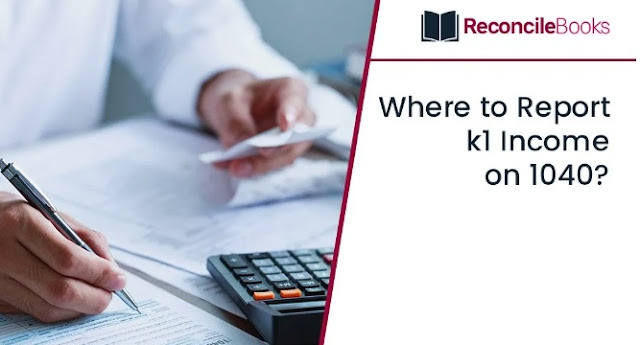How to Report K-1 Income on Form 1040
- Get link
- X
- Other Apps
Are you tired of making mistakes on your K-1 income when filing your taxes? Don't worry, we've got you covered. Filing taxes can be a daunting task, but it doesn't have to be. In this blog post, we will dive into the common mistakes people make when filling out their K-1 income on Form 1040 and how to avoid them. So sit back, relax and let's get started on ensuring your tax return is error-free!
Filing K-1 income on Form 1040
If you are unmarried and your partner earned income during the year, you may have to file a joint tax return. If you file jointly, both of your incomes will be combined on Form 1040. Your partner's income will show up on line 21 (with some exceptions). You will also have to include any K-1 income on your return.
K-1 visas are issued to foreign nationals who want to marry a U.S. citizen. The foreigner must provide documentation that the marriage is bona fide (legal) and the couple must wait at least 90 days after the wedding to file a joint tax return.
If you are filing as married filing jointly, K-1 income will automatically show up on your return as long as it was received by the end of the year and wasn't included in other income. However, if there is any question about whether the Report K-1 Income on Form 1040, you may have to seek advice from a tax professional.
There are a few
things to keep in mind when filing your taxes:
You don't have to include any K-1 income on your original Form 1040 unless it was received during 2018 or 2019 and was above $20,000.
If you withdraw any of the money from the account used to invest in the spouse's company, this could be considered taxable earnings, so include that information on Schedule C with your other business expenses.
What is Schedule K-1?
Schedule K-1 is a tax form that is used to report income from an S-corporation. It can be used to help you avoid common mistakes when filing your taxes.
When you file your taxes, you will need to include Schedule K-1 with your tax return. This form will show the income and expenses of your S-corporation.
There are a few things to keep in mind when filling out Schedule K-1. First, make sure you list all of the income earned by your S-corporation on this form. This includes both taxable and nontaxable income.
Also, be sure to list all of the expenses incurred by your S-corporation on this form. These expenses can include amounts paid for goods and services, as well as depreciation costs.
Finally, make sure you file this form with the correct tax year. Your S-corporation will generally have one tax year, which runs from January 1 to December 31. Make sure you file your taxes based on this calendar year so that you can correctly reflect the income and expenses of your S-corporation on Schedule K-1
Filing requirements for Schedule K-1
When you file your income taxes, there are a few things you need to keep in mind if you're reporting Schedule K-1.
Here are the
basics:
First, you'll need to file Form 1065, U.S. Income Tax Return for Partnership, and Form 1066, U.S. Income Tax Return for an S Corporation. These forms will tell the government which individual partners or shareholders earned income and what portion of that income was taxed as corporate income or as capital gains or losses.
You'll also need to make sure that all of your partners and shareholders have completed and filed their own Forms 1065 and 1066. If one of your participants doesn't file their return on time, you may be subject to penalties and interest.
Finally, be sure to attach Schedule K-1 (Form 1065) to your tax returns when filing them with the IRS. This form lists each partner's share of the partnership's taxable income and total deductions (including itemized deductions). You can use this information to help figure out your individual tax liability.
Reporting your K-1 Income on your Federal Tax Return
If you are in a joint return filing status and you have income from a K-1 visa, you must report the income on your federal tax return. The form that you use to report the income is Form 1040, Schedule K-1.
The first step is to figure out what kind of income you have. You can find this information on the front of the Form 1040, which is usually listed under "Income."
You also need to determine if you are required to file a tax return. If so, go to File Your Tax Return and follow the instructions. If not, skip ahead to Step 2.
The next step is to figure out how much of your income is from your spouse. To do this, divide your total income by 2. This will give you your share of the income from your spouse.
Next, figure out what taxes (if any) you owe on that share of the income. This includes both federal and state taxes. Add these amounts together and then compare it to the sum of all other taxes that you owe for the year (line 38 on Form 1040). If it's less than line 38, then stop here and don't do anything else with your Form 1040. You're done!
If it's not less
than line 38, however, there are still some steps that you need to take:
There are a few exceptions to the filing requirement for K-1s. If you are a qualifying child of an employee who is performing services in the United States, you do not have to file a K-1 with your tax return. You can simply report the income on Form 1040, line 21 as wages. Likewise, if you are the spouse of such an employee and meet certain conditions, you may also qualify for this exception and not have to file a K-1.
If you are entitled to claim any income or benefits from a foreign source on your tax return, including wages or other compensation paid by a U.S. employer to an employee who is resident in a foreign country but doing work in the United States, then you must file a K-1 form even if no other income is reported on your tax return. The form will indicate the amount of income received and identify which taxes were withheld.
What to do if you have missing or incorrect information on your Schedule K-1
If you have missing or incorrect information on your Schedule K-1, you can correct it using the instructions IRS Payment Plan for 1040 Tax Return. You can also use the IRS Online Tax Assistant to check your return and correct any errors. If you need help preparing your return, please call 1347-967-4079 our office.
Conclusion
Whether you are an individual or a business, it is important to be aware of the mistakes that can lead to potential taxes and penalties. In this article, we discuss some of the most common mistakes people make when filing their K-1 income on Form 1040 and provide tips on how to avoid them. By following these simple steps, you will ensure that your taxes are as low as possible and that you don't end up facing any surprises during tax time IRS Payment Plan for 1040.
- Get link
- X
- Other Apps



Comments
Post a Comment